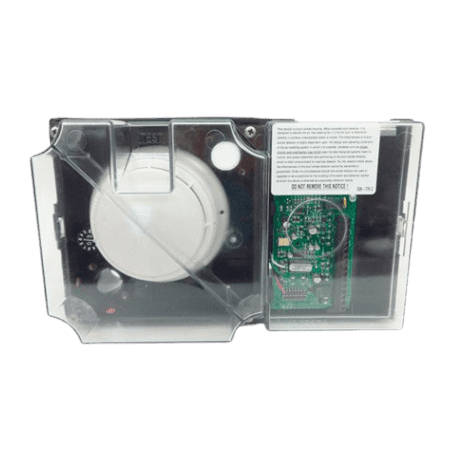Features
Compact air duct sensor housing with clear
cover to monitor for the presence of smoke**
Includes factory installed TrueAlarm
photoelectric smoke sensor and features:
- Individual sensor information processed by the host control panel to determine sensor status
- Digital transmission of analog sensor values via IDNet or MAPNET II, 2-wire communications
- Programmable sensitivity, consistent accuracy, environmental compensation, status testing, and monitoring of sensor dirt accumulation
Model 4098-9756:
- Duct sensor housing with supervised output for multiple remote relays; requires separate 24 VDC; includes one relay
- Relay output is under panel control
- At the panel, relay output can be activated manually or in response to a separate alarm or other input
General features:
- UL listed to Standard 268A
- Clear cover allows visual inspection
- Test ports provide functional smoke testing access with cover in place
- Mounts to rectangular ducts or round ducts; minimum size is 8” (203 mm) square or 18” (457 mm) diameter
- Magnetic test feature for alarm initiation at housing
- Optional weatherproof enclosure is available separately (refer to data sheet S4098-0032)
Diagnostic LEDs (on interface board):
- Red Alarm/Trouble LED for sensor status and communications polling display
- Yellow LED for open or shorted trouble indication of supervised relay control (4098-9756 only)
Sampling tubes (ordered separately):
- Available in multiple lengths to match duct size
- Installed and serviced with housing in place
Remote module options (ordered separately):
- Remote red status/alarm LED (2098-9808)
- Remote test station with LED (2098-9806)
- 4098-9843 remote relays (refer to page 2 for details)
Introduction
Operation. Simplex ® compact air duct smoke sensor
housings provide TrueAlarm operation for the detection of
smoke in air conditioning or ventilating ducts. Sampling
tubes are installed into the duct allowing air to be directed to
the smoke sensor mounted in the housing.
TrueAlarm Sensor Operation
Digital Communication of Analog Sensing.
Analog information from the sensor is digitally
communicated to the control panel where it is analyzed.
Sensor input is stored and tracked as an average value
with an alarm or abnormal condition being determined by
comparing the sensor’s present value against its average.
Intelligent Data Evaluation. Monitoring each
photoelectric sensor’s average value provides a software
filtering process that compensates for environmental
factors (dust, dirt, etc.) and component aging, providing
an accurate reference for evaluating new activity. The
result is a significant reduction in the probability of false
or nuisance alarms caused by shifts in sensitivity, either
up or down.
Control Panel Selection. Peak activity per sensor is
stored to assist in evaluating specific locations. The alarm
set point for each sensor is determined at the control
panel, selectable as the individual application requires.
Sensor Status LED. Each sensor housing’s red status
LED (located on the electrical interface board) pulses to
indicate communications with the panel. If the control
panel determines that a sensor is in alarm, or that it is
dirty or has some other type of trouble, the details are
annunciated at the control panel and that sensor housing’s
status LED will be turned on steadily. During a system
alarm, the control panel will control the LEDs such that
an LED indicating a trouble will return to pulsing to help
identify any alarmed sensors. (Remote Status/Alarm
LEDs track the operation of the sensor housing LED.)
Photoelectric Sensing
TrueAlarm photoelectric sensors use a stable, pulsed
infrared LED light source and a silicon photodiode
receiver to provide consistent and accurate low power
smoke sensing.
Typically duct sensor applications require less sensitive
settings (such as 2.5% per foot obscuration) due to the
ducts being a relative dirty environment. However, the
standard seven levels of TrueAlarm sensor sensitivity are
available for each individual sensor, ranging from 0.2% to
3.7% per foot of smoke obscuration. Sensitivity is
selected and monitored at the fire alarm control panel.
